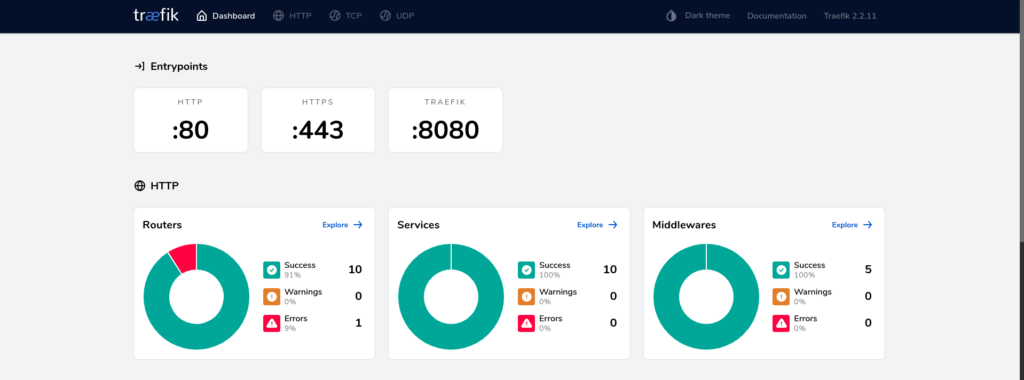After A LOT of struggling to get Nexus 3 running behind Traefik2 I finally got in working, so I thought let’s share this with rest of the world… 😀
Running the GUI behind Traefik2 wasn’t a big deal… It was logging in and pushing the images to it that was a pain in the ass…
So… For everyone that is struggling with the same issue… Here is the answer… (I hope for you). And the problem wasn’t even my docker-compose file… But a setting IN Nexus 3…
My Setup is a docker swarm with 5 nodes. So just keep in mind that my docker-compose file is for a swarm (includes deploy settings and stuff). As an extra I also run my persistent storage on NFS. So it doesn’t matter on which worker the conatiner get’s deployed… So let’s start with the compose files:
Traefik V2
version: "3.7"
networks:
proxy:
driver: overlay
external: true
default:
driver: overlay
########################### SERVICES
services:
############################# FRONTENDS
# Traefik 2 - Reverse Proxy
# Touch (create empty files) traefik.log and acme/acme.json. Set acme.json permissions to 600.
# touch $DOCKERDIR/traefik2/acme/acme.json
# chmod 600 $DOCKERDIR/traefik2/acme/acme.json
# touch $DOCKERDIR/traefik2/traefik.log
traefik:
image: traefik:v2.2
environment:
- AWS_HOSTED_ZONE_ID=${AWS_HOSTED_ZONE_ID}
- AWS_ACCESS_KEY_ID=${AWS_ACCESS_KEY_ID}
- AWS_SECRET_ACCESS_KEY=${AWS_SECRET_ACCESS_KEY}
hostname: traefik
ports:
- "80:80"
- "443:443"
deploy:
restart_policy:
condition: on-failure
mode: replicated
placement:
constraints:
- node.role == manager
- node.hostname == elb.mydomain.com
labels:
- "traefik.enable=true"
- "traefik.docker.network=proxy"
- "traefik.http.routers.api.entrypoints=https"
- "traefik.http.routers.api.rule=Host(`elb.mydomain.com`)"
- "traefik.http.routers.api.service=api@internal"
- "traefik.http.routers.api.tls=true"
- "traefik.http.routers.api.tls.domains[0].main=mydomain.com"
- "traefik.http.routers.api.tls.domains[0].sans=*.mydomain.com"
- "traefik.http.routers.api.tls.certresolver=mytlschallenge"
- "traefik.http.routers.api_http.entrypoints=http"
- "traefik.http.routers.api_http.rule=Host(`elb.mydomain.com`)"
- "traefik.http.routers.api_http.middlewares=traefik-redirectscheme"
- "traefik.http.middlewares.traefik-redirectscheme.redirectscheme.scheme=https"
- "traefik.http.services.api.loadbalancer.server.port=8080"
## Middlewares
- "traefik.http.routers.traefik-rtr.middlewares=middlewares-basic-auth@file"
command:
- --api.insecure=true # set to 'false' on production
- --api.dashboard=true
- --api.debug=false
- --log.level=WARN
- --providers.docker=true
- --providers.docker.swarmMode=true
- --providers.docker.exposedbydefault=false
- --providers.docker.network=proxy
- --entrypoints.http.address=:80
- --entrypoints.https.address=:443
- --certificatesresolvers.mytlschallenge.acme.dnsChallenge.resolvers=1.1.1.1:53,8.8.8.8:53
#- --certificatesResolvers.mytlschallenge.acme.caServer=https://acme-staging-v02.api.letsencrypt.org/directory # Generates LE test certificates. Can be removed for production
- --certificatesResolvers.mytlschallenge.acme.dnsChallenge=true
- --certificatesResolvers.mytlschallenge.acme.dnsChallenge.provider=route53
- --certificatesresolvers.mytlschallenge.acme.email=${LE_EMAIL}
- --certificatesresolvers.mytlschallenge.acme.storage=/letsencrypt/acme.json
- --serverstransport.insecureskipverify=true
volumes:
- "nfs_traefik:/letsencrypt"
- /var/run/docker.sock:/var/run/docker.sock:ro
networks:
- proxy
volumes:
nfs_traefik:
external: trueNexus 3:
version: "3.7"
services:
nexus:
image: sonatype/nexus3
environment:
- "REGISTRY_HTTP_RELATIVEURLS=true"
- "TZ=Europe/Brussels"
deploy:
mode: replicated
replicas: 1
restart_policy:
condition: on-failure
placement:
constraints:
- node.role == worker
labels:
- "traefik.enable=true"
# Nexus Interface
- "traefik.http.routers.nexus.entrypoints=https"
- "traefik.http.routers.nexus.service=nexus"
- "traefik.http.routers.nexus.rule=Host(`nexus.mydomain.com`)"
- "traefik.http.routers.nexus.tls.certresolver=mytlschallenge"
- "traefik.http.services.nexus.loadbalancer.server.port=8081"
# Regsitry Endpoint
- "traefik.http.routers.registry.rule=Host(`registry.mydomain.com`)"
- "traefik.http.routers.registry.tls=true"
- "traefik.http.routers.registry.service=registry"
- "traefik.http.routers.registry.tls.certresolver=mytlschallenge"
- "traefik.http.services.registry.loadbalancer.server.port=5000"
- "traefik.docker.network=proxy"
volumes:
- "nexus_data:/nexus-data"
networks:
- proxy
ports:
- "8081:8081"
- "5000:5000"
volumes:
nexus_data:
driver: local
driver_opts:
type: nfs
o: addr=192.168.86.12,rw
device: ":/volume1/Docker/NexusData"
networks:
proxy:
external: true
If you deploy these 2 compose files (replacing mydomain.com with your domain) you should have a running traefik V2 (with GUI, on elb.mydomain.com), a nexus running on nexus.mydomain.com and a repository endpoint on registry.mydomain.com.
The first time you open nexus you will be asked to give the admin user and the password… You can find this password under /nexus-data/admin.password in your container or nfs share if you did the same as me. Afterwards, just follow the setup.
Let’s create a Docker repository
Go to –> Settings –> Repositories –> Create Repository
- Give the name of your repository
- Check the HTTP connector and add port 5000 (the port you mentioned in the traefik labels for the repository url)
- If you want to allow anonymous pulls, you can check that too (optional)
- And I’ve also enabled the Docker V1 api (optional)
- Click on “Save”
Now, if you try to login…
koen@pop-os:~/Projects/Docker/docker-ha/build$ docker login -u admin -p Password https://registry.mydomain.com:5000
Error response from daemon: Get https://registry.mydomain.com:5000/v2/: dial tcp 192.168.86.200:5000: connect: connection refused
OR
koen@pop-os:~/Projects/Docker/docker-ha/build$ docker login -u admin -p Password https://registry.mydomain.com
Error response from daemon: login attempt to https://registry.mydomain.com/v2/ failed with status: 404 Not FoundAfter A LOT of Googling around… I finally found the solution to this problem… Which wasn’t the traefik config… So here it comes… 😀
Go to Settings –> Realms and add the Docker Bearer Token Realm…

Now try to login again…
koen@pop-os:~/Projects/Docker/docker-ha/build$ docker login -u admin -p Password https://registry.mydomain.com
Login Succeeded



Recent Comments